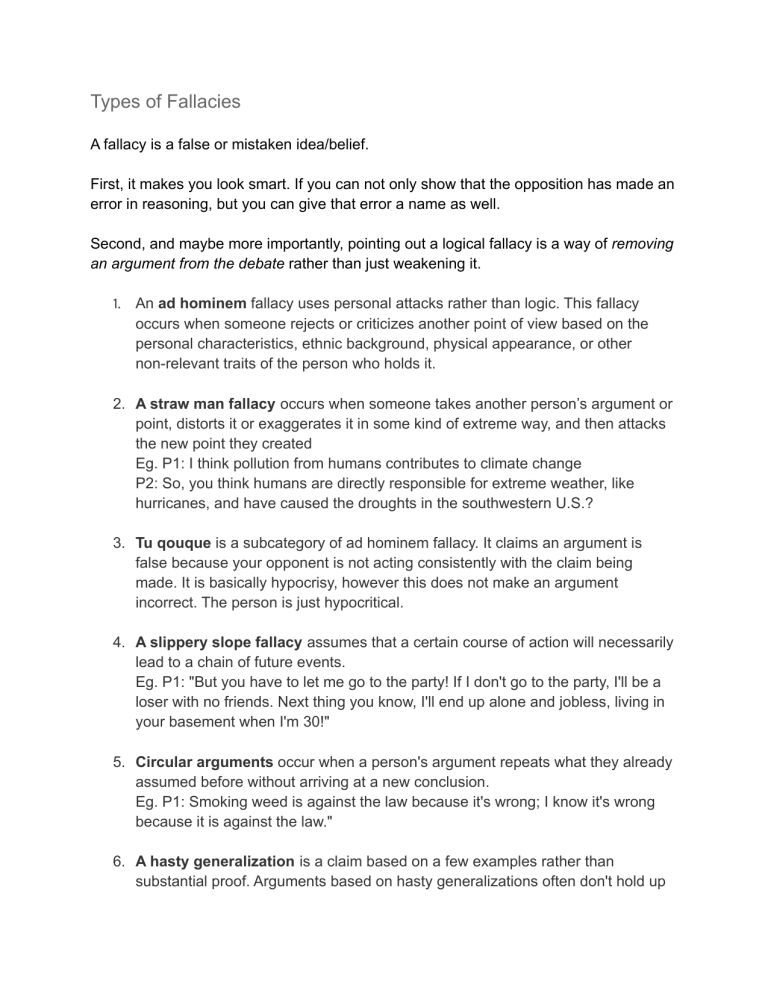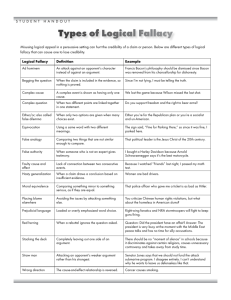
Types of Fallacies A fallacy is a false or mistaken idea/belief. First, it makes you look smart. If you can not only show that the opposition has made an error in reasoning, but you can give that error a name as well. Second, and maybe more importantly, pointing out a logical fallacy is a way of removing an argument from the debate rather than just weakening it. 1. An ad hominem fallacy uses personal attacks rather than logic. This fallacy occurs when someone rejects or criticizes another point of view based on the personal characteristics, ethnic background, physical appearance, or other non-relevant traits of the person who holds it. 2. A straw man fallacy occurs when someone takes another person’s argument or point, distorts it or exaggerates it in some kind of extreme way, and then attacks the new point they created Eg. P1: I think pollution from humans contributes to climate change P2: So, you think humans are directly responsible for extreme weather, like hurricanes, and have caused the droughts in the southwestern U.S.? 3. Tu qouque is a subcategory of ad hominem fallacy. It claims an argument is false because your opponent is not acting consistently with the claim being made. It is basically hypocrisy, however this does not make an argument incorrect. The person is just hypocritical. 4. A slippery slope fallacy assumes that a certain course of action will necessarily lead to a chain of future events. Eg. P1: "But you have to let me go to the party! If I don't go to the party, I'll be a loser with no friends. Next thing you know, I'll end up alone and jobless, living in your basement when I'm 30!" 5. Circular arguments occur when a person's argument repeats what they already assumed before without arriving at a new conclusion. Eg. P1: Smoking weed is against the law because it's wrong; I know it's wrong because it is against the law." 6. A hasty generalization is a claim based on a few examples rather than substantial proof. Arguments based on hasty generalizations often don't hold up due to a lack of supporting evidence: The claim might be true in one case, but that doesn't mean it's always true. 7. A red herring is an argument that uses confusion or distraction to shift attention away from a topic and toward a false conclusion. Red herrings usually contain an unimportant fact, idea, or event that has little relevance to the real issue. Red herrings are a common diversionary tactic when someone wants to shift the focus of an argument to something easier or safer to address. 8. Argument or appeal to numbers -This fallacy is the attempt to prove something by showing how many people think that it's true. But no matter how many people believe something, that doesn't necessarily make it true or right. Example: "At least 70% of all Americans support restrictions on access to abortions." Well, maybe 70% of Americans are wrong. 9. Argument to the point of disgust (by repetition)- This is the fallacy of trying to prove something by saying it again and again. But no matter how many times you repeat something, it will not become any more or less true than it was in the first place. 10. Sticking to your script! While this is not necessarily a fallacy, it is annoying.



